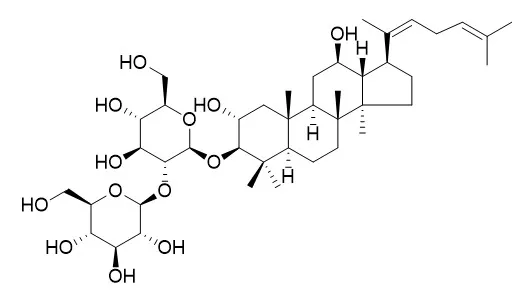| In vitro: |
| Bioorganic & Medicinal Chemistry, 2011, 19(21):6254-6260. | | New dammarane-type glucosides as potential activators of AMP-activated protein kinase (AMPK) from Gynostemma pentaphyllum.[Pubmed: 21978948] | AMP-activated protein kinase (AMPK) is a key sensor and regulator of glucose, lipid, and energy metabolism throughout the body. Activation of AMPK improves metabolic abnormalities associated with metabolic diseases including obesity and type-2 diabetes. The oriental traditional medicinal herbal plant, Gynostemma pentaphyllum, has shown a wide range of beneficial effects on glucose and lipid metabolism.
METHODS AND RESULTS:
In this study, we found that G. pentaphyllum contains two novel dammarane-type saponins designated as Damulin A (1), 2α,3β,12β-trihydroxydammar-20(22)-E,24-diene-3-O-[β-D-glucopyranosyl-(1→2)-β-D-glucopyranoside], and damulin B (2), 2α,3β,12β-trihydroxydammar-20,24-diene-3-O-[β-D-glucopyranosyl-(1→2)-β-D-glucopyranoside], that strongly activate AMPK in cultured L6 myotube cells. Damulin A and Damulin B also increased β-oxidation and glucose uptake with increasing GluT4 translocation to the plasma membrane in L6 myotube cells.
CONCLUSIONS:
Taken together our results indicate that activation of AMPK by Damulin A and Damulin B may contribute to beneficial effect of G. pentaphyllum on glucose and lipid metabolism. |
|






 Cell. 2018 Jan 11;172(1-2):249-261.e12. doi: 10.1016/j.cell.2017.12.019.IF=36.216(2019)
Cell. 2018 Jan 11;172(1-2):249-261.e12. doi: 10.1016/j.cell.2017.12.019.IF=36.216(2019) Cell Metab. 2020 Mar 3;31(3):534-548.e5. doi: 10.1016/j.cmet.2020.01.002.IF=22.415(2019)
Cell Metab. 2020 Mar 3;31(3):534-548.e5. doi: 10.1016/j.cmet.2020.01.002.IF=22.415(2019) Mol Cell. 2017 Nov 16;68(4):673-685.e6. doi: 10.1016/j.molcel.2017.10.022.IF=14.548(2019)
Mol Cell. 2017 Nov 16;68(4):673-685.e6. doi: 10.1016/j.molcel.2017.10.022.IF=14.548(2019)